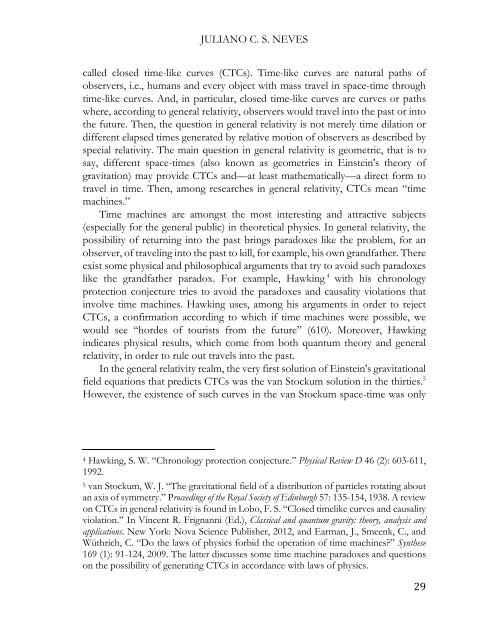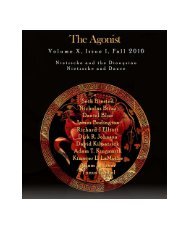Volume XII, Issue II, Spring 2019
Create successful ePaper yourself
Turn your PDF publications into a flip-book with our unique Google optimized e-Paper software.
JULIANO C. S. NEVES<br />
called closed time-like curves (CTCs). Time-like curves are natural paths of<br />
observers, i.e., humans and every object with mass travel in space-time through<br />
time-like curves. And, in particular, closed time-like curves are curves or paths<br />
where, according to general relativity, observers would travel into the past or into<br />
the future. Then, the question in general relativity is not merely time dilation or<br />
different elapsed times generated by relative motion of observers as described by<br />
special relativity. The main question in general relativity is geometric, that is to<br />
say, different space-times (also known as geometries in Einstein's theory of<br />
gravitation) may provide CTCs and—at least mathematically—a direct form to<br />
travel in time. Then, among researches in general relativity, CTCs mean “time<br />
machines.”<br />
Time machines are amongst the most interesting and attractive subjects<br />
(especially for the general public) in theoretical physics. In general relativity, the<br />
possibility of returning into the past brings paradoxes like the problem, for an<br />
observer, of traveling into the past to kill, for example, his own grandfather. There<br />
exist some physical and philosophical arguments that try to avoid such paradoxes<br />
like the grandfather paradox. For example, Hawking 4 with his chronology<br />
protection conjecture tries to avoid the paradoxes and causality violations that<br />
involve time machines. Hawking uses, among his arguments in order to reject<br />
CTCs, a confirmation according to which if time machines were possible, we<br />
would see “hordes of tourists from the future” (610). Moreover, Hawking<br />
indicates physical results, which come from both quantum theory and general<br />
relativity, in order to rule out travels into the past.<br />
In the general relativity realm, the very first solution of Einstein's gravitational<br />
field equations that predicts CTCs was the van Stockum solution in the thirties. 5<br />
However, the existence of such curves in the van Stockum space-time was only<br />
4 Hawking, S. W. “Chronology protection conjecture.” Physical Review D 46 (2): 603-611,<br />
1992.<br />
5 van Stockum, W. J. “The gravitational field of a distribution of particles rotating about<br />
an axis of symmetry.” Proceedings of the Royal Society of Edinburgh 57: 135-154, 1938. A review<br />
on CTCs in general relativity is found in Lobo, F. S. “Closed timelike curves and causality<br />
violation.” In Vincent R. Frignanni (Ed.), Classical and quantum gravity: theory, analysis and<br />
applications. New York: Nova Science Publisher, 2012, and Earman, J., Smeenk, C., and<br />
Wüthrich, C. “Do the laws of physics forbid the operation of time machines?” Synthese<br />
169 (1): 91-124, 2009. The latter discusses some time machine paradoxes and questions<br />
on the possibility of generating CTCs in accordance with laws of physics.<br />
29









